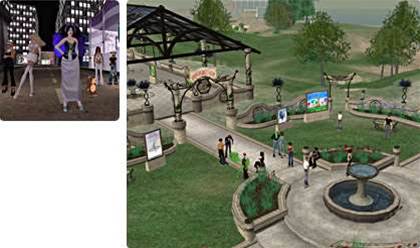
Launched in 2003 by Linden Lab, Second Life is said to have over 386,000 registered users who inhabit the 3D world via personalised avatars.
Users walk, fly and teleport around the virtual land's locations. The goal of the game is to have social interactions and do business with other players.
Earlier this month, Sun launched its Sun Pavilion in Second Life, featuring interactive kiosks and an outdoor theatre that was used for a 'press conference' with an avatar representing Sun chief researcher John Gage.
Chris Melissinos, Sun's chief gaming officer, said that the Pavilion was constructed along with Sun's marketing arm, and that the project was not as big an undertaking as some people had expected.
"One of the great things about Second Life is that everyone has a chance to do something just as big," Melissinos told vnunet.com. "It was a very straightforward process. One that anyone can enjoy."
High levels of user involvement in the game are one of the main lures for companies, according to James Belcher, a senior analyst at EMarketer.
"Second Life has an enormous amount of user-generated content, so the stuff that catches on has been vetted and spread by word of mouth within the community," he told vnunet.com.
This sort of involvement makes Second Life the perfect medium for viral marketing campaigns, according to Belcher.
"You can become part of their gaming experience, and you have the opportunity to meet a targeted audience where word can spread quickly," he said.
User-driven online projects such as Second Life, however, are not always open to commercial interests joining their communities because of fears that 'big money' will ruin the 'social experiment'.
Games developer Wagner James Au, a self-described "embedded journalist", has chronicled Second Life for three and a half years in his New World Notes blog.
Au has seen Second Life grow from a close-knit, subscription-based community into a virtual world hosting a myriad of dedicated groups with various interests and levels of involvement.
When Au sold a virtual island to a London-based branding company in 2004, unhappy players gave their avatars protest signs and sent them to the island.
"They believed that they were building this utopia that was separate from the real world, and then this guy came in and said: 'I'm going to bring in brands.' People started to freak out," Au told vnunet.com.
Users have come to terms with the corporate elements in Second Life, Au claimed, mainly because those who do not wish to view the corporate areas are under no obligation to do so.
Commercial islands in Second Life, which today sell for US$1,250 and US$195 per month in rent, are not seen in the main areas of the virtual world. Instead they are accessed by 'teleporting'.
The relationship between the companies venturing into Second Life and the user community can be mutually beneficial, according to Au.
"The top users are making their living through Second Life. They have a vested interest in companies coming into the world, and the theory is that if Linden Lab the company thrives, then the Second Life community thrives," said Au.
Au also pointed out that it is not just advertising that is bringing companies into Second Life. It also gives them a place to show off their technology.
IBM, for instance, actively helped to improve the game when one of its researchers developed a plug-in that offers real-time translations of conversations through the Babelfish translation service.
Sun Microsystems plans to use its Second Life headquarters as more than simply a virtual showroom. The Sun Pavilion will also serve as a hub for users and developers to get the latest information on Sun's Project Darkstar online game-hosting service.
"We are going to continue to provide Sun information, as well as doing some fun things just to get the community together and get the games side together. We are going to use it for a mash-up of different things," said Melissinos.
The Sun and IBM initiatives appears to be catching on. Online publisher CNET recently opened the doors of a virtual corporate headquarters in Second Life, and the Reuters press agency set up a virtual news bureau earlier this week.
"A lot of companies have gone beyond the marketing thing," said Au. "Companies are seeing Second Life as the next operating system."

_(22).jpg&h=140&w=231&c=1&s=0)
_(20).jpg&h=140&w=231&c=1&s=0)





_(26).jpg&w=100&c=1&s=0)

 iTnews Executive Retreat - Security Leaders Edition
iTnews Executive Retreat - Security Leaders Edition











_(1).jpg&h=140&w=231&c=1&s=0)



